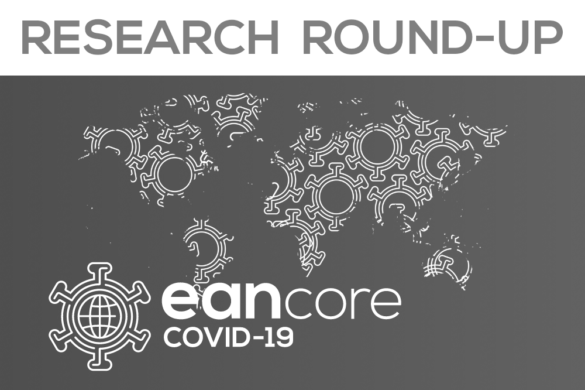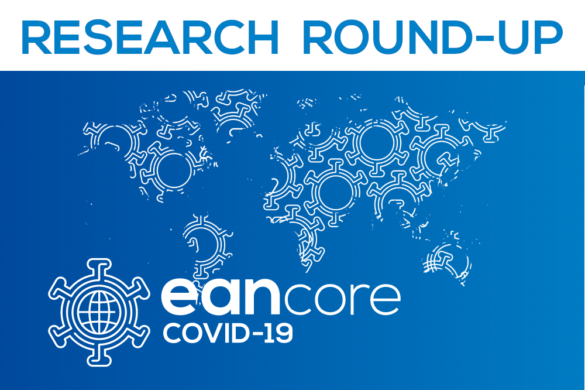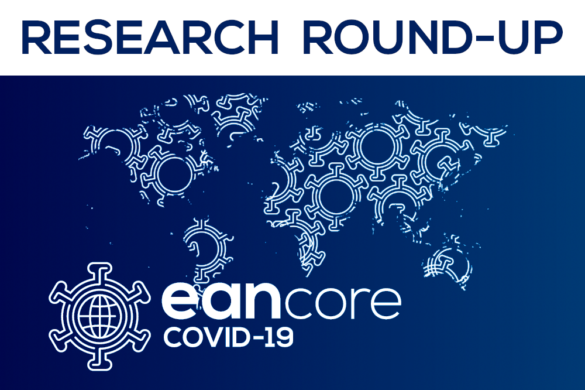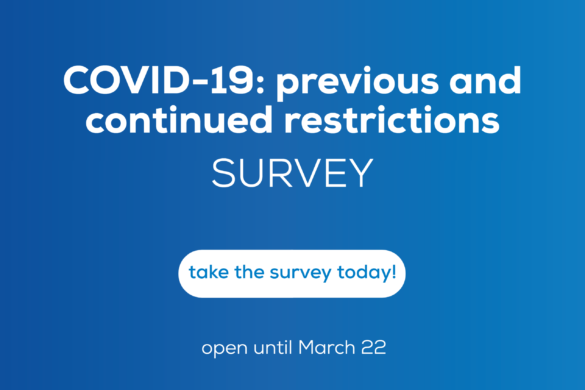Interventional studies with open label/non-randomised methodology (Yellow)
Read on for our highlighted selection of Covid-related interventional studies with open label or non-randomised methodology from the scientific press for January 2022:
- REGEN-COV Antibody Combination and Outcomes in Outpatients with COVID-19
- Namilumab or infliximab compared with standard of care in hospitalised patients with COVID-19 (CATALYST): a randomised, multicentre, multi-arm, multistage, open-label, adaptive, phase 2, proof-of-concept trial
- Rivaroxaban versus no anticoagulation for post-discharge thromboprophylaxis after hospitalisation for COVID-19 (MICHELLE): an open-label, multicentre, randomised, controlled trial
REGEN-COV Antibody Combination and Outcomes in Outpatients with COVID-19
In the phase 1–2 portion of an adaptive trial, REGEN-COV, a combination of the monoclonal antibodies casirivimab and imdevimab, reduced the viral load and number of medical visits in patients with coronavirus disease 2019 (COVID-19). REGEN-COV has activity in vitro against current severe acute respiratory syndrome coronavirus 2 (SARS-CoV-2) variants of concern. In the phase 3 portion of an adaptive trial, the authors randomly assigned outpatients with COVID-19 and risk factors for severe disease to receive various doses of intravenous REGEN-COV or placebo. Patients were followed through day 29. A prespecified hierarchical analysis was used to assess the end points of hospitalization or death and the time to resolution of symptoms. Safety was also evaluated. COVID-19–related hospitalization or death from any cause occurred in 18 of 1355 patients in the REGEN-COV 2400-mg group (1.3%) and in 62 of 1341 patients in the placebo group who underwent randomization concurrently (4.6%) (relative risk reduction [1 minus the relative risk], 71.3%; P<0.001); these outcomes occurred in 7 of 736 patients in the REGEN-COV 1200-mg group (1.0%) and in 24 of 748 patients in the placebo group who underwent randomization concurrently (3.2%) (relative risk reduction, 70.4%; P=0.002). The median time to resolution of symptoms was 4 days shorter with each REGEN-COV dose than with placebo (10 days vs. 14 days; P<0.001 for both comparisons). REGEN-COV was efficacious across various subgroups, including patients who were SARS-CoV-2 serum antibody–positive at baseline. Both REGEN-COV doses reduced viral load faster than placebo; the least-squares mean difference in viral load from baseline through day 7 was −0.71 log10 copies per milliliter (95% confidence interval [CI], −0.90 to −0.53) in the 1200-mg group and −0.86 log10 copies per milliliter (95% CI, −1.00 to −0.72) in the 2400-mg group. Serious adverse events occurred more frequently in the placebo group (4.0%) than in the 1200-mg group (1.1%) and the 2400-mg group (1.3%); infusion-related reactions of grade 2 or higher occurred in less than 0.3% of the patients in all groups. The authors concluded that REGEN-COV reduced the risk of COVID-19–related hospitalization or death from any cause, and it resolved symptoms and reduced the SARS-CoV-2 viral load more rapidly than placebo.
Weinreich DM, Sivapalasingam S, Norton T, Ali S, Gao H, Bhore R, Xiao J, Hooper AT, Hamilton JD, Musser BJ, Rofail D, Hussein M, Im J, Atmodjo DY, Perry C, Pan C, Mahmood A, Hosain R, Davis JD, Turner KC, Baum A, Kyratsous CA, Kim Y, Cook A, Kampman W, Roque-Guerrero L, Acloque G, Aazami H, Cannon K, Simón-Campos JA, Bocchini JA, Kowal B, DiCioccio AT, Soo Y, Geba GP, Stahl N, Lipsich L, Braunstein N, Herman G, Yancopoulos GD; Trial Investigators. REGEN-COV Antibody Combination and Outcomes in Outpatients with COVID-19. N Engl J Med. 2021 Dec 2;385(23):e81. doi: 10.1056/NEJMoa2108163.
Namilumab or infliximab compared with standard of care in hospitalised patients with COVID-19 (CATALYST): a randomised, multicentre, multi-arm, multistage, open-label, adaptive, phase 2, proof-of-concept trial
Dysregulated inflammation is associated with poor outcomes in COVID-19. In this study the authors aimed to assess the efficacy of namilumab (a granulocyte-macrophage colony stimulating factor inhibitor) and infliximab (a tumour necrosis factor inhibitor) in hospitalised patients with COVID-19, to prioritise agents for phase 3 trials. In this randomised, multicentre, multi-arm, multistage, parallel-group, open-label, adaptive, phase 2, proof-of-concept trial (CATALYST), patients (aged ≥16 years) admitted to hospital with COVID-19 pneumonia and C-reactive protein (CRP) concentrations of 40 mg/L or greater, were recruited at nine hospitals in the UK. Participants were randomly assigned with equal probability to usual care or usual care plus a single intravenous dose of namilumab (150 mg) or infliximab (5 mg/kg). Randomisation was stratified by care location within the hospital (ward vs intensive care unit [ICU]). Patients and investigators were not masked to treatment allocation. The primary endpoint was improvement in inflammation, measured by CRP concentration over time, analysed using Bayesian multilevel models. Between June 15, 2020, and Feb 18, 2021, 299 patients were screened and 146 were enrolled and randomly assigned to usual care (n=54), namilumab (n=57), or infliximab (n=35). For the primary outcome, 45 patients in the usual care group were compared with 52 in the namilumab group, and 29 in the usual care group were compared with 28 in the infliximab group. The probabilities that the interventions were superior to usual care alone in reducing CRP concentration over time were 97% for namilumab and 15% for infliximab; the point estimates for treatment–time interactions were –0·09 (95% CI –0·19 to 0·00) for namilumab and 0·06 (–0·05 to 0·17) for infliximab. 134 adverse events occurred in 30 (55%) of 55 patients in the namilumab group compared with 145 in 29 (54%) of 54 in the usual care group. 102 adverse events occurred in 20 (69%) of 29 patients in the infliximab group compared with 112 in 17 (50%) of 34 in the usual care group. Death occurred in six (11%) patients in the namilumab group compared with ten (19%) in the usual care group, and in four (14%) in the infliximab group compared with five (15%) in the usual care group. Namilumab, but not infliximab, showed proof-of-concept evidence for reduction in inflammation—as measured by CRP concentration—in hospitalised patients with COVID-19 pneumonia. Furthermore, Namilumab should be prioritised for further investigation in COVID-19.
Fisher BA, Veenith T, Slade D, Gaskell C, Rowland M, Whitehouse T, Scriven J, Parekh D, Balasubramaniam MS, Cooke G, Morley N, Gabriel Z, Wise MP, Porter J, McShane H, Ho LP, Newsome PN, Rowe A, Sharpe R, Thickett DR, Bion J, Gates S, Richards D, Kearns P; CATALYST investigators. Namilumab or infliximab compared with standard of care in hospitalised patients with COVID-19 (CATALYST): a randomised, multicentre, multi-arm, multistage, open-label, adaptive, phase 2, proof-of-concept trial. Lancet Respir Med. 2021 Dec 16:S2213-2600(21)00460-4. doi: 10.1016/S2213-2600(21)00460-4.
Rivaroxaban versus no anticoagulation for post-discharge thromboprophylaxis after hospitalisation for COVID-19 (MICHELLE): an open-label, multicentre, randomised, controlled trial
Patients hospitalised with COVID-19 are at risk for thrombotic events after discharge; the role of extended thromboprophylaxis in this population is unknown. In this open-label, multicentre, randomised trial conducted at 14 centres in Brazil, patients hospitalised with COVID-19 at increased risk for venous thromboembolism (International Medical Prevention Registry on Venous Thromboembolism [IMPROVE] venous thromboembolism [VTE] score of ≥4 or 2–3 with a D-dimer >500 ng/mL) were randomly assigned (1:1) to receive, at hospital discharge, rivaroxaban 10 mg/day or no anticoagulation for 35 days. The primary efficacy outcome in an intention-to-treat analysis was a composite of symptomatic or fatal venous thromboembolism, asymptomatic venous thromboembolism on bilateral lower-limb venous ultrasound and CT pulmonary angiogram, symptomatic arterial thromboembolism, and cardiovascular death at day 35. Adjudication was blinded. The primary safety outcome was major bleeding. The primary and safety analyses were carried out in the intention-to-treat population. From Oct 8, 2020, to June 29, 2021, 997 patients were screened. Of these patients, 677 did not meet eligibility criteria; the remaining 320 patients were enrolled and randomly assigned to receive rivaroxaban (n=160 [50%]) or no anticoagulation (n=160 [50%]). All patients received thromboprophylaxis with standard doses of heparin during hospitalisation. 165 (52%) patients were in the intensive care unit while hospitalised. 197 (62%) patients had an IMPROVE score of 2–3 and elevated D-dimer levels and 121 (38%) had a score of 4 or more. Two patients (one in each group) were lost to follow-up due to withdrawal of consent and not included in the intention-to-treat primary analysis. The primary efficacy outcome occurred in five (3%) of 159 patients assigned to rivaroxaban and 15 (9%) of 159 patients assigned to no anticoagulation (relative risk 0·33, 95% CI 0·12–0·90; p=0·0293). No major bleeding occurred in either study group. Allergic reactions occurred in two (1%) patients in the rivaroxaban group. The authors concluded that in patients at high risk discharged after hospitalisation due to COVID-19, thromboprophylaxis with rivaroxaban 10 mg/day for 35 days improved clinical outcomes compared with no extended thromboprophylaxis.
Ramacciotti E, Barile Agati L, Calderaro D, Aguiar VCR, Spyropoulos AC, de Oliveira CCC, Lins Dos Santos J, Volpiani GG, Sobreira ML, Joviliano EE, Bohatch Júnior MS, da Fonseca BAL, Ribeiro MS, Dusilek C, Itinose K, Sanches SMV, de Almeida Araujo Ramos K, de Moraes NF, Tierno PFGMM, de Oliveira ALML, Tachibana A, Chate RC, Santos MVB, de Menezes Cavalcante BB, Moreira RCR, Chang C, Tafur A, Fareed J, Lopes RD; MICHELLE investigators. Rivaroxaban versus no anticoagulation for post-discharge thromboprophylaxis after hospitalisation for COVID-19 (MICHELLE): an open-label, multicentre, randomised, controlled trial. Lancet. 2021 Dec 15:S0140-6736(21)02392-8. doi: 10.1016/S0140-6736(21)02392-8.









